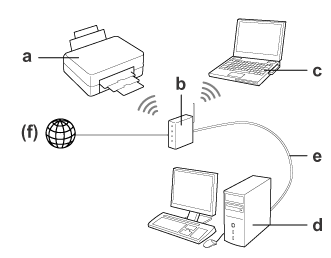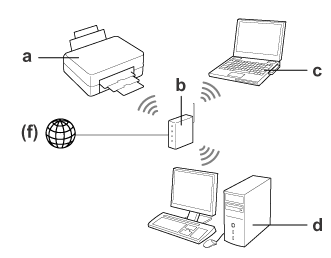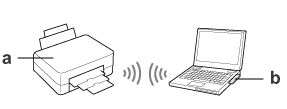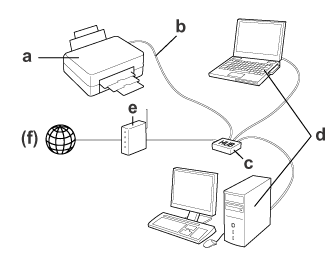 |
 |
|
||
 |
||||
Network Connection Basics
This section explains three basic network connection types. (Depending on the printer, all connection types may not be available.)
Wi-Fi (wireless) network
To communicate through the access point (Infrastructure mode)
In the Infrastructure mode, both wireless and wired computers can communicate through an access point (such as wireless router) to send data to the network interface.


Hardware necessary for infrastructure mode
a. Printer
b. Wireless router (or access point)
c. Computer with Wi-Fi interface (built-in or added via USB/PC card and so on)
d. Computer with LAN port or Wi-Fi interface
e. Ethernet cable (if you connect the computer and the wireless router directly)
(f. Internet access)
To communicate without using an access point (Ad Hoc mode)
To use the printer in a wireless environment without an access point (wireless router, etc.), you can use Ad Hoc mode. For more details, see Ad Hoc mode.

Hardware necessary for Ad Hoc mode
a. Printer
b. Computer with a Wi-Fi interface (built-in or added via USB/PC card and so on)
To communicate without using an access point (Wi-Fi Direct)
The other way to use the printer in a wireless environment without an access point is to use a Wi-Fi Direct connection.
If either the printer or the computer (or Wi-Fi device) has a Wi-Fi Direct function, you can connect the printer wirelessly without using an access point.
For more details, see Wi-Fi Direct.

Hardware necessary for Wi-Fi Direct mode
a. Printer (built-in Wi-Fi Direct function)
b. Computer (with a Wi-Fi interface) or a Wi-Fi device
Ethernet (wired) network
For a wired network connection, connect the hub/router to the printer using the Ethernet cable.

Hardware necessary for a wired network
a. Printer
b. Ethernet cable
c. Ethernet HUB
d. Computer with LAN port
e. Router
(f. Internet access)
